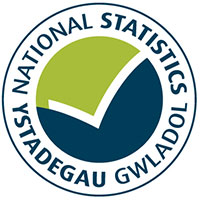Labour market data for UK countries and regions and also for local areas for October 2019 to September 2020.
This is not the latest release in the series: Labour market statistics (Annual Population Survey)
The Annual Population Survey (APS) combines the boosted samples of the Labour Force Survey (LFS). It provides rolling four-quarter labour market data for UK countries and regions and also for local areas. For Wales, the APS consists of a sample of about 18,000 households every year.
The LFS remains the main source for headline labour market indicators at a Wales level. The larger sample of the APS allows for estimates at a local authority level and for sub-groups of the population.
The data for this period covers six months of the coronavirus (COVID-19) pandemic as well as six months prior to the start of the pandemic, and therefore should be treated with caution. In the Key Economic Statistics release, we have included analysis on data sources that are giving more timely indications on how the pandemic is affecting the labour market in Wales.
Employment
- The employment rate for people aged 16 to 64 in Wales was 73.3%, down 0.2 percentage points on the previous year. The UK rate was 75.5%, remaining unchanged over the year.
- Since 2001, the employment rate has increased by 6.2 percentage points in Wales and by 3.6 percentage points in the UK.
- The highest estimated employment rates were in Monmouthshire (80.6%), Flintshire (78.9%) and Newport (76.8%).
- The lowest estimated employment rates were in Merthyr Tydfil (68.1%), Rhondda Cynon Taf (68.5%) and Swansea (69.7%).
Unemployment
- The unemployment rate for people aged 16 and over in Wales was 3.6%, down 0.5 percentage points compared with the previous year. The UK rate was 4.1%, up 0.2 percentage points over the year.
- Since 2001, the unemployment rate has fallen by 1.8 percentage points in Wales and by 0.9 percentage points in the UK.
- The lowest estimated unemployment rates were in Newport (2.0%), Carmarthenshire and Cardiff (both 2.7%).
- The highest estimated unemployment rates were in Merthyr Tydfil (6.5%), Rhondda Cynon Taf (5.7%) and Swansea (5.6%).
- Please note data for Neath Port Talbot, Bridgend and Pembrokeshire have been suppressed due to inadequate sample size.
Youth unemployment
- The youth unemployment rate in Wales was 10.4%, below the UK rate of 12.4%.
- Since 2001, the youth unemployment rate fell 3.8 percentage points in Wales, but rose by 0.6 percentage points in the UK.
Long term unemployment
- 24.7% of unemployed people in Wales had been unemployed for 12 months or more. This compares with 21.0% in the UK.
Economic inactivity (excluding students)
- The economic inactivity rate for people aged 16 to 64 in Wales was 19.9%, up 0.2 percentage points compared with the previous year. The UK was 17.2%, down 0.2 percentage points over the year.
- Since 2001, the economic inactivity rate fell by 6.5 percentage points in Wales and by 4.2 percentage points in the UK.
- The lowest estimated economic inactivity rates were in Monmouthshire (13.3%), Cardiff (14.5%) and Flintshire (15.8%).
- The highest estimated economic inactivity rates were in Neath Port Talbot (23.8%), Blaenau Gwent (23.5%) and Merthyr Tydfil (23.0%).
Protected characteristics
The APS allows for analysis of labour market data split by protected characteristics. These data are published on StatsWales. Figures suggest that some protected groups of people have been more adversely affected in terms of the labour market by the pandemic. We will continue to explore this as more timely data becomes available.
- The economic inactivity rate (including students) for people who are disabled under the Equality Act definition in Wales increased by 1.4 percentage points over the year. For people who are not disabled under the Equality Act definition, it increased by 0.7 percentage points over the same period.
- The economic inactivity rate (including students) increased by 2.7 percentage points for people who are Black, Asian and Minority Ethnic in Wales over the year. Over the same period, it increased by 0.4 percentage points for people who are white.
- The employment rate for people who are Black, Asian and Minority Ethnic in Wales decreased by 1.6 percentage points over the year. The employment rate for people who are white remained unchanged.
- The economic inactivity rate (excluding students) for males in Wales increased by 1.5 percentage points. For females, it decreased by 1.1 percentage points over the same period.
- The employment rate for males in Wales decreased over the year by 1.0 percentage points. For females, it increased by 0.6 percentage points over the same period.
Datasets and interactive tools
Contact
Vanessa Allis
Telephone: 0300 025 9019
Email: economic.stats@gov.wales
Rydym yn croesawu galwadau a gohebiaeth yn Gymraeg / We welcome calls and correspondence in Welsh.
Media
Telephone: 0300 025 8099
Rydym yn croesawu galwadau yn Gymraeg / We welcome calls in Welsh.

